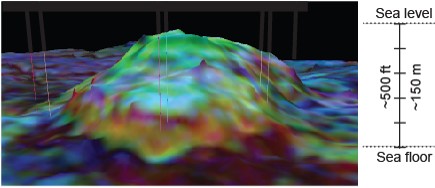Balcones Igneous Province Reservoirs
_Regional Geology.jpg)
Oil production from volcanic reservoirs
Since 1915 approximately 120 volcanic oil fields have been discovered in the Balcones Igneous Province (BIP), collectively producing over 100 million barrels of oil. Most of the volcanic reservoirs occur at shallow depths, which keeps drilling costs low. A comprehensive analysis of the distribution and volume of produced oil from volcanic reservoirs, as well as sedimentary reservoirs that were influenced by volcanism, highlights areas with remaining commercial potential.

Volcanic-tuff reservoirs
Balcones Igneous Province oil-bearing volcanic rocks consist of heavily altered tuffs which originally formed marine cinder cones. These tuffs now form small mounds which, where shallowly buried by Cretaceous chalks and shales, can be extremely porous (up to 39%). Many of these pores; however, are micro- to nanopores which contribute little to permeability. Alteration has reduced most of the original volcanic minerals and glass to vermiculite, smectite, and, in some samples, serpentine.
Source rocks of volcanic-reservoir oils
Molecular compositions of oils from volcanic-tuff reservoirs in Williamson County correlate with those of lower Eagle Ford self-sourcing unconventional reservoirs east of the San Marcos Arch and indicate generation and migration from lower Eagle Ford shales in the peak-oil window (~1.1 %Ro). The Eagle Ford-sourced oils, as well as minor oil contributions from Austin Chalk or Pepper Shale source rocks, likely migrated via fractures and permeable strata from downdip areas in northern Burleson and southern Lee Counties 40 miles to the east.
Carbonate reservoirs associated with Balcones Igneous Province volcanoes
Associated with many of these volcanic mounds in the Balcones Igneous Province are coarser grained carbonates that originated in shallower water carbonate factories at mound tops and upper flanks. These carbonates that were deposited in shallow-water shoaling environments supplied sediment to form deep-water gravity-flow deposits on the volcanic flanks and toe-of-slopes. Many of these carbonate deposits are hydrocarbon producing reservoirs.

Architecture of a Balcones Igneous Province volcano
A 3-D seismic dataset and associated cores in Dimmit and Zavala Counties were analyzed to define the internal architecture of the Elaine field volcano and the distribution associated carbonate deposits. The results indicate that the internal architecture of the volcano is complex and is composed of multiple vents creating significance heterogeneity to reservoir compartmentalization. Seismic facies show the broad distribution of carbonate debrites around the volcano.


